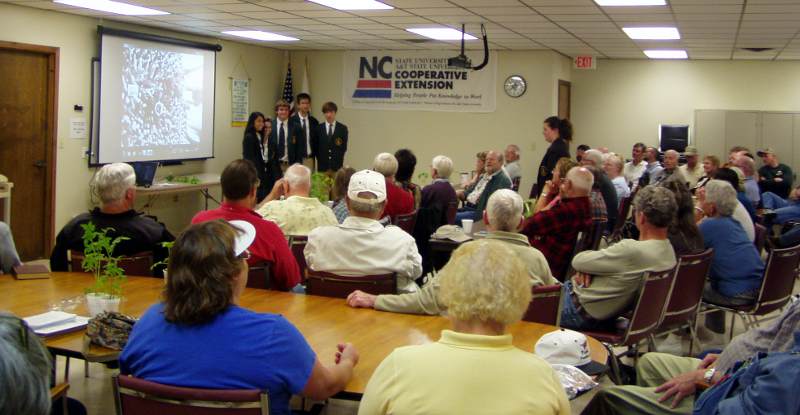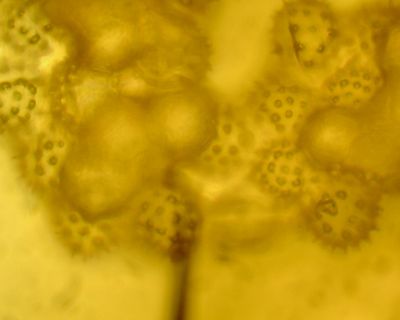Education and Bee Science
Contents
High School Curriculum
In 2011, Blue Ridge Honey Company donated a hive. Set up as an 21st century observation hive. Registered as GA004 with NASA's Honey Bee Net.
The hive has been used For the last two years, during the first week of classes, the students extract honey
Spring 2012
Fall 2012
Students extracted honey from the hive.
Spring 2013
Three projects using the bees were entered in the Rabun Gap-Nacoochee School 2012-2013 Science Symposium.
The results of their findings were presented at a Macon County Beekeepers Association meeting.
A 60 inch high definition TV was installed in the entrance to the Morris Brown Science Building can stream live bee activity and hive weight.
Fall 2013
In the fall of 2013, 70 pounds of honey was extracted. and sold in one pound jars to parents for $10 a jar.
During the extraction, a frame of drone brood that was in the honey super was examined for varroa mites.
Curriculum
Biology
Parasites - introduced invasive pests, disease vectors, integrated pest management
Varroa mites (Varroa destructor) are small, reddish-brown tick like pests which feed on the hemolymph ("blood") of the honey bees. The feeding of the mites on the bee opens wounds which are sites for possible infection. In addition, the mite will infect the bee with viruses. Tracheal mites are microscopic mites which reproduce in the trachea (airways) of the bee.
- Assess varroa mite levels in the hive using a sticky board.
- Assess varroa mite wound damage and tracheal mite infestation using a dissecting microscope.
- Determine the cost/benefits of different mite controls: formic acid, thymol, Taktic, cumophos
- Design, test and implement a pest control policy.
Polymerase Chain Reaction (PCR) amplification
- <a href=diversity-02-00610.pdf>DNA Barcoding for Honey Biodiversity</a>
- <a href=foodchemhoneypcr.pdf>Development of primer and probe sets for the detection of plant species in honey</a>
- <a href=honeypcr.pdf>Tracking Plant, Fungal, and Bacterial DNA in Honey Specimens</a>
Bioacoustics
Botany
|
<img width=500px src=rgns_pollen1.jpg> |
|
Pollen lab at <a href=http://rabungap.org>RGNS</a> |
Melissopalynology - food source and quality
- Collect voucher specimens from a 2 mile radius of the hive.
- Use GPS and/or google maps to locate the nectar and pollen sources.
- Prepare slides, make photomicrographs, build an online pollen database.
- Take pollen and nectar samples from hive. Identify source of nectar flow.
- Identify and count pollen in local and commercial honey.
Greg Bisbee's Arrowhead High School <a href=http://www.woodrow.org/teachers/bi/1997/pollen2/>Pollen Lab.</a>
University of Arizona <a href=http://www.geo.arizona.edu/palynology/polonweb.html>Catalog of
Internet Pollen and Spore Images</a>
Science & Plants for Schools - <a href=http://www-saps.plantsci.cam.ac.uk/pollen/>Pollen Image Library</a>
Radboud University Virtual Classroom <a href=http://www.vcbio.science.ru.nl/en/virtuallessons/pollenmorphology/>Pollen - Shape, Color & Size</a>
USDA, ARS, APMRU, Pollen Lab <a href=http://pollen.usda.gov/index.htm>Pollen as Indicators of Source Areas and Foraging Resources</a>
Horticulture/Phenology
Use ambient temperature data from the hive to calculate <a href=http://en.wikipedia.org/wiki/Growing_degree_day>Growing Degree Day</a> (GDD) to predict nectar flow.
Chemistry & Physics
- Test for sugar adulteration.
- Test for Insecticides/Fungicides
<a href="http://www.honey-for-health.com/test-for-pure-honey.html#pay_it_forward">Test for Pure Honey</a>
<a href=http://www.fas.harvard.edu/~scdiroff/lds/LightOptics/SugarSyrups/SugarSyrups.html>Sugar Syrups
optical activity - circular polarization - helical molecules</a>
<a href=http://www.exploratorium.edu/snacks/rotating_light/>Rotating Light</a>
Peter Keusch's <a href=http://www.demochem.de/D-honey_amylase-e.htm>Test for Amylase in Bee Honey</a>
Peter Keusch's <a href=http://www.demochem.de/D-Fehling-e.htm>Fehling's Test</a>
Peter Keusch's <a href=http://www.demochem.de/D-art_honey-e.htm>Artificial Honey - Formation of a Sweet Imitation</a>
|
<img width=500px src=rgns_MCBA_presentation_2013.jpg> |
|
Figure 2. <a href=http://rabungap.org>RGNS</a> students presenting <a href=rgns_projects_2013.html>bee research projects</a> to Macon County Beekeepers Association in Franklin, NC. |
Communication
- Write research grant proposals and present to State Beekeepers Assoc.
- Publish research
Computers
- Interface instruments to computer
- Logging
- Web server setup and administration
- Data base server setup and administration
Video
- <a href=http://homepages.inf.ed.ac.uk/rbf/VAIB08PAPERS/vaib9_mummert.pdf>Intel Research Pittsburgh, Video Monitoring of honey Bee Colonies</a>
- <a href=http://opencv.willowgarage.com/wiki/>Open Computer Vision</a>
- Zoneminder
- Timelapse
- <a href=http://www.classifynder.com/sites/default/papers/CraigThesis1.pdf>Automation of Pollen Analysis using a Computer</a>
Math/Programing
- Calibrate instruments - linear scaling, regression.
- Statistics.
- Audio analysis - time domain/frequency domain, Fourier transform.
- Audio synthesis - waveforms, sine wave, square wave
- Graphing - implement graphing software for web server

